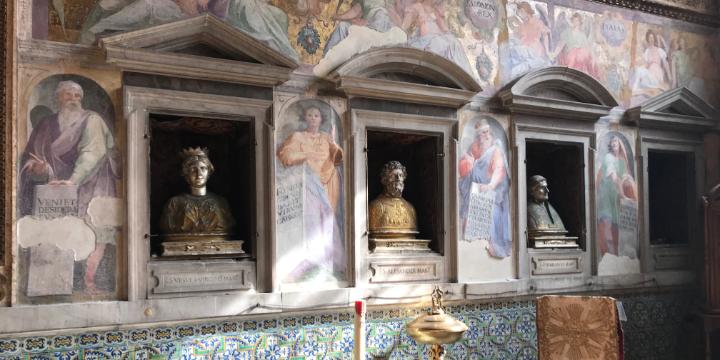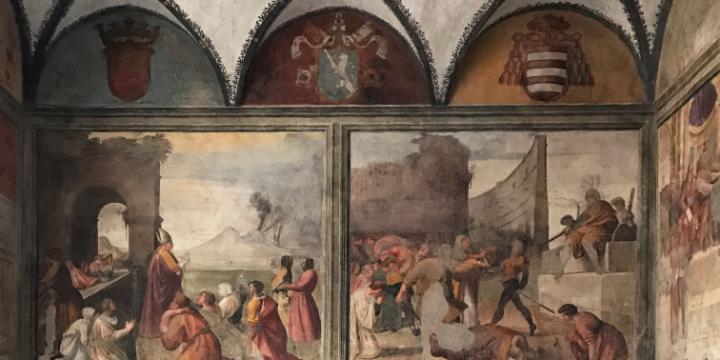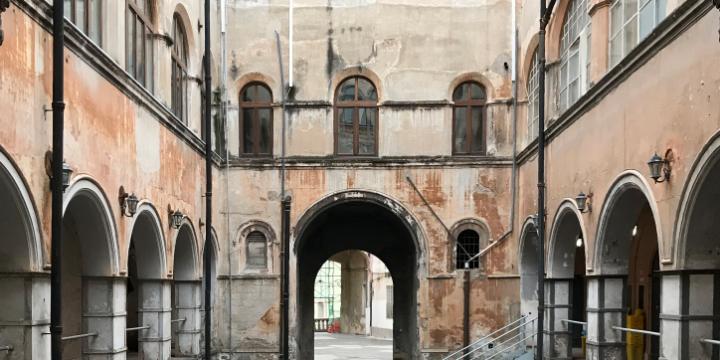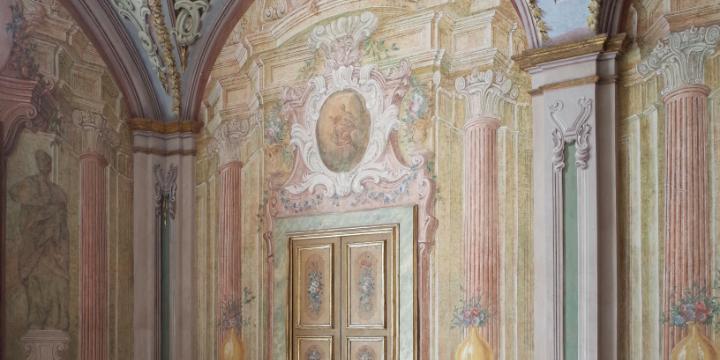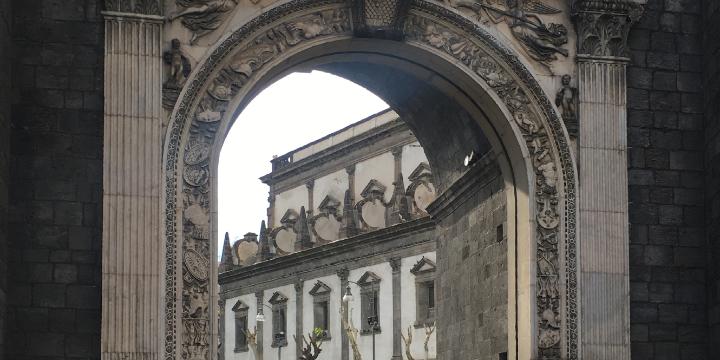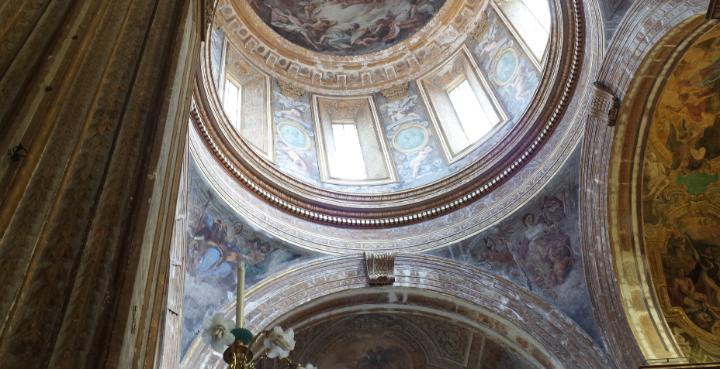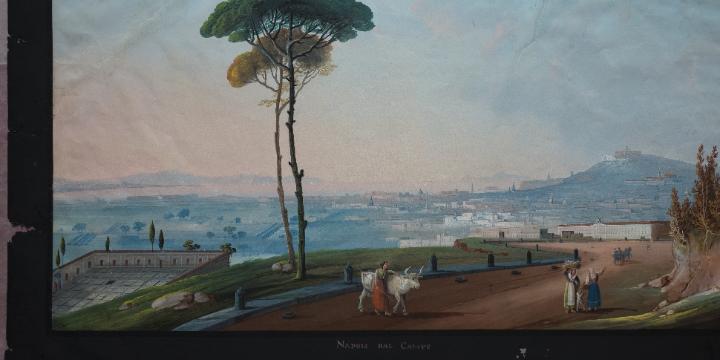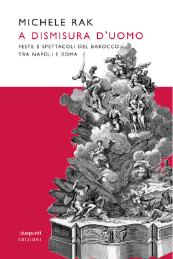Neapolitan Network
Home
The Neapolitan Network supports interdisciplinary and cross-period research on Naples (broadly defined). It draws together Neapolitanists from around the world facilitating academic exchange, meetings, conferences, and research projects relating to Naples, including city and Kingdom, and related research topics. It was founded in 2014 by Melissa Calaresu (University of Cambridge) and Helen Hills (University of York), with the generous financial support of the AHRC (Arts and Humanities Research Council).
Click here to find out more.
Fields of Research
• Theological, religious, devotional, ritual
• Consumption, food, tourism, antiquarianism, sciences, historiography
Fellowships and Grants
Members are welcome to suggest relevant entries for this page. E-mail: fb798@york.ac.uk
Membership and Contacts
For membership, or to add your event (members only):
Please contact Fabrizio Ballabio (email: fb798@york.ac.uk)
The Neapolitan Network is now free of charge. This is a great opportunity to join us!
Take advantage of the Special Reductions.
For other general issues please contact:
Helen Hills
Professor of History of Art
Department of History of Art
University of York
Heslington
N. Yorkshire
YO10 5DD UK
tel: 01904 433428
email: hh508@york.ac.uk
website
News and Events
Members are welcome to suggest relevant titles for this page. Particular emphasis will be given to publications authored by members. E-mail: fb798@york.ac.uk
2019
Center for the Art and Architectural History of Port Cities
Naples
The Center for the Art and Architectural History of Port Cities, founded in 2018 as a collaboration between the Museo e Real Bosco di Capodimonte in Naples and the Edith O'Donnell Institute of Art History at The University of Texas at Dallas, takes the city of Naples as a laboratory for new research in the cultural histories of port cities and the mobilities of artworks, people, technologies, and ideas.
Housed in La Capraia, a rustic eighteenth-century agricultural building at the heart of the Bosco di Capodimonte, the Center is dedicated to exploring global histories of art, architecture, and cultural production while grounded in direct study of artworks, sites, and archives in Naples and Southern Italy.
Through research residencies, site-based seminars, and programs organized with partner institutions, the Center promotes scholarly access to Naples, fosters and communicates new research on Naples and on other port cities, and cultivates an intellectual community of students and scholars working at the intersection of the global and the local.
Download an overview of the Center here. A call for applications for the 2020/2021 Research Residencies at La Capraia will follow shortly.
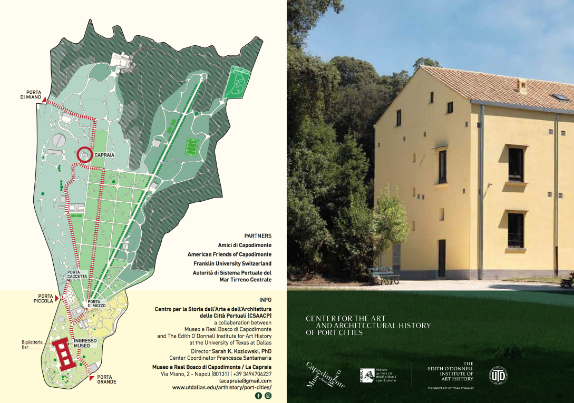
Field seminar:
Gateways to Medieval Naples
8-10 June 2020
Naples
The Bibliotheca Hertziana - Max-Planck-Institut für Kunstgeschichte (Rome), the Università degli Studi di Napoli Federico II - Dipartimento di Studi Umanistici (Naples), and the Centro per la Storia dell’Arte e dell’Architettura delle Città Portuali (Naples) are co-organizing a field seminar called Gateways to Medieval Naples, to be held in Naples June 8-10, 2020. Grounded in collaborative on-site study of works of art and animated by collegial exchange of ideas, the seminar will convene a small group of scholars to share and further develop the latest research on Naples and to chart new methodological approaches to this complex nexus of the medieval world. The organizing committee invites established and emerging scholars to submit proposals for on-site or roundtable presentations on topics from late antiquity through the fifteenth century.
For more information and to consult to the Call for Proposals, visit: https://www.biblhertz.it/en/gateways-medieval-naples
Call for Proposals Deadline: 17 November 2019
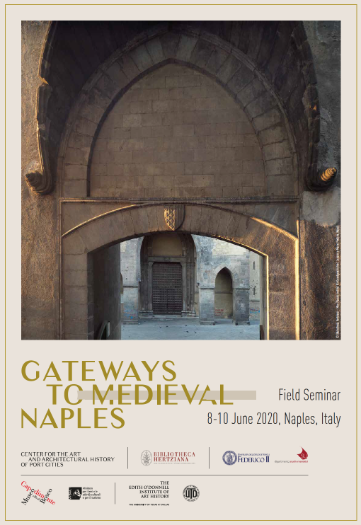
Itineraria tridentina. Giovanni Balducci, Alfonso Gesualdo e la riforma delle arti a Napoli
27 September
Florence, Palazzo Corsini - Salone del Trono
Fondazione De Vito is presenting the Mauro Vincenzo Fontana's volume Itinera tridentina. Giovanni Balducci, Alfonso Gesualdo e la riforma delle arti a Napoli (Artemide, 2019). The event is part of the public programme of the XXXI Mostra Internazionale dell'Antiquariato at Palazzo Corsini.
For more information, visit: www.biaf.it
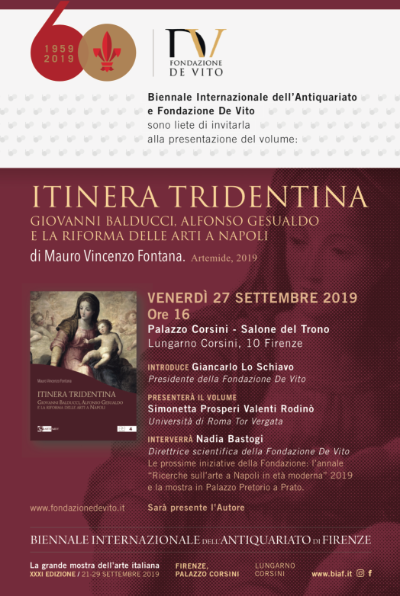
International Conference:
Oceans, Art and Markets. Fifty Years of International Research and Methodologies
30-31 May, 1 June
Napoli, La Capraia - Museo e Real Bosco di Capodimonte
The conference Oceans, Art and Markets conference. Fifty Years of International Research and Methodologies, promoted by the Museum and Real Bosco di Capodimonte and by the Edith O 'Donnell Institute, together with the art historian Sabina de Cavi from the University of Córdoba, is a survey on the scholarship and on the different research approaches to themes of the circulation by sea of merchants, artists and works of art in early modern Europe.
The conference is hosted in the venue of the Centro per la Storia dell’Arte e dell’Architettura delle Città Portuali (CSAACP), at La Capraia in the Real Bosco di Capodimonte.
For further details, visit: http://www.museocapodimonte.beniculturali.it/convegno-internazionale-oceans-art-and-markets-fifty-years-of-international-research-and-methodologies/
Richerche sull'arte a Napoli in età Moderna. Saggi e Documenti 2017-2018
1 February, 4:30 pm
Florence, Fondazione De Vito - Sala Convegni della Fondazione Biblioteche Cassa di Risparmio di Firenze
Fondazione De Vito is presenting the 32nd edition of its yearly Ricerche sull'arte a Napoli in età Moderna. Saggi e Documenti 2017-2018.
For further details, visit: http://www.fondazionedevito.it
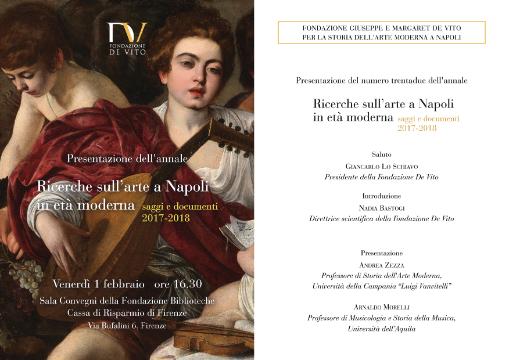
2017
Study Day
La Copia pittorica a Napoli tra Cinquecento e Seicento
23 January, 9:15 am
Napoli, Gallerie d'Italia - Palazzo Zevallos-Stigliano
This Study Day is organised by David Garcia Cueto e Andrea Zezza and, thanks to the contribution of well-known Italian and Spanish scholars, aims to focus the attention for the first time on the copies executed by the Neapolitan School and their dissemination.
Programme available here: Giornata di Studio (PDF ![]() , 364kb)
, 364kb)
Study Day
27 January, 2:30 pm
Fondazione Longhi, Firenze
This Study Day is organised by the Fondazione Longhi di Firenze in memory of ing. Giuseppe De Vito and his contribution to the study of Neapolitan art.
The Study Day will start with the greetings from the Directors of Fondazione Longhi and Fondazione De Vito, followed by other speakers: Nadia Bastogi, Renato Ruotolo, Elena Fumagalli, Alberto Cottino, Daniele Benati.
Symposium
'Spanish Royal Geographies in Early Modern Europe and America: Rethinking the Royal Sites / Geographies of Habsburg Politics and Religion'
4-5 May
University of York, UK
Organised by the Centre for Renaissance and Early Modern Studies, University of York, in collaboration with the University of Rey Juan Carlos, Madrid (URJC), and IULCE (the University Institute 'La Corte en Europa') of the Autonomous University of Madrid (UAM).
Please download the programme here: Programme Symposium (MS Word ![]() , 37kb).
, 37kb).
Symposium: Naples and the Museo e Real Bosco di Capodimonte in a Global Context
12-14 October
Naples
To launch a new collaboration between the Edith O’Donnell Institute of Art History and the Museo e Real Bosco di Capodimonte dedicated to innovative research on art in Naples and on the cultural histories of port cities, this symposium brings together an international group of scholars for two days of on-site presentations that will set Naples and the Capodimonte in a global context.
See more information here.
2016
Open Arts Journal research seminar
2 March, 6 pm
The Open University in London, 1 - 11 Hawley Crescent, Camden NW1 8NP
The Open Arts Journal, in collaboration with the Department of Art History, The Open University, is hosting a research seminar on Wednesday 2 March, from 6pm, at The Open University in London. This event celebrates the publication of issue 4 of the Journal earlier this year. Our speaker is Helen Hills (University of York), whose paper is entitled, Silver & Salvation: Colonial Excess and Baroque Naples. The proceedings will be followed by a reception.
All are welcome!
Follow this link to our event bookings website (eventbrite) to reserve your place: http://openartsjournal-researchseminar.eventbrite.co.uk or email Alice Sanger, Deputy Editor, Open Arts Journal, a.e.sanger@open.ac.uk.
Open Arts Journal (PDF ![]() , 231kb)
, 231kb)
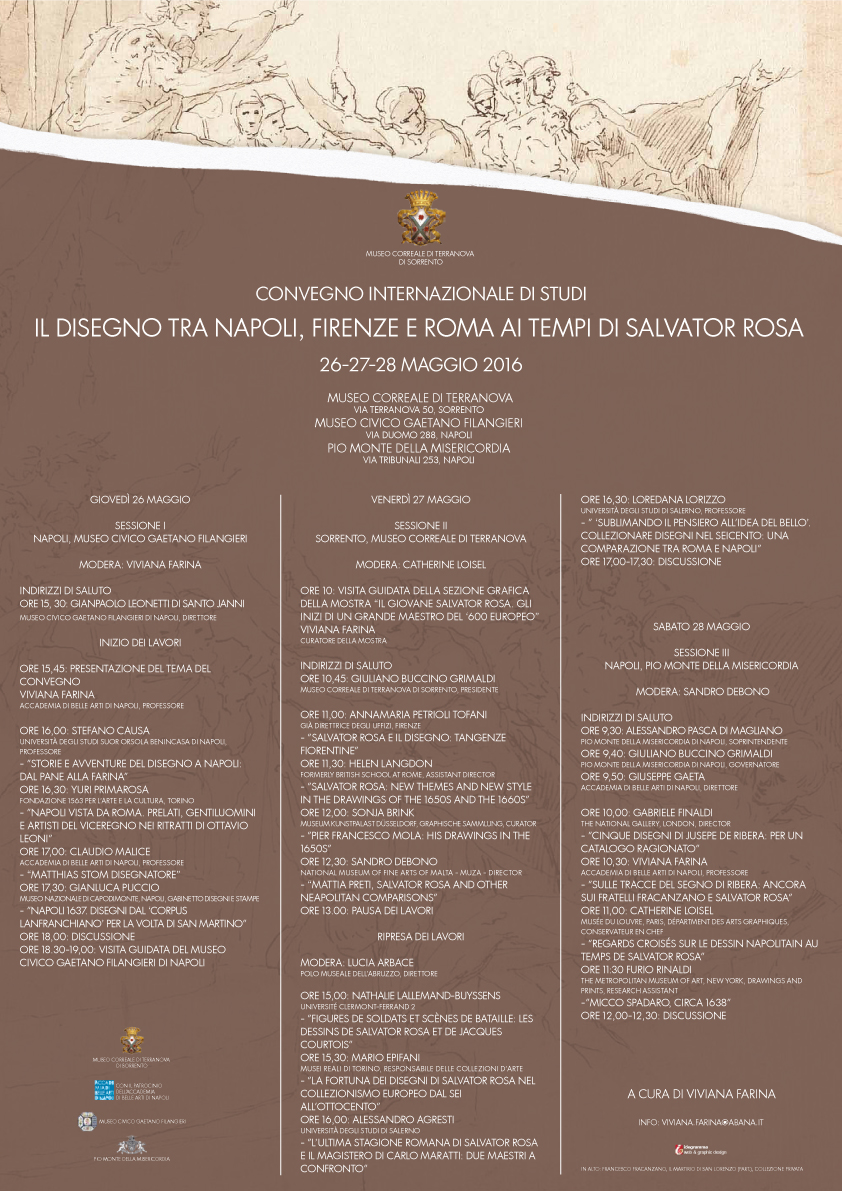
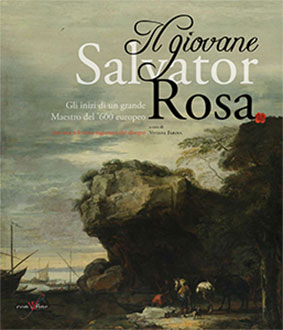
2015
CFP: Painting in Naples 1600-1656
61st Annual Meeting of the Renaissance Society of America, Berlin, March 26 - 28, 2015
Captivating female saints, violent martyrdoms, painted with quick palpable brushstrokes; intricate iconographies of mythology and devotion. Neapolitan painting is often characterized by art historians as being dramatic in expression, with a strong emphasis on naturalism and intense chiaroscuro. However, this portrayal does little to address its material, intellectual, and spiritual dynamics. This session seeks to explore the wealth of Neapolitan painting between 1600 - just before Caravaggio's arrival in the city - and the plague of 1656. Within this period, important foreign artists like Caravaggio, Ribera, Domenichino, Artemisia Gentileschi and Mattia Preti entered into a creative interaction with local artists like Caracciolo, Stanzione, Falcone and Cavallino. Their art developed divergently within the context of literary academies, the Neapolitan elite, the viceregal court and ecclesiastical institutions.
In this session, we want to address the most recent developments of international research on Neapolitan painting. We welcome papers on individual artworks that illustrate important aspects of Neapolitan art, such as materiality, spirituality, iconography, violence, intellectual context and patronage. By focusing on individual paintings, we aim to create a virtual “Galleria” of Neapolitan art.
Please send your 150 word-abstract with title and key words and your CV (max. 300) to Bogdan Cornea (ibc500@york.ac.uk) and Marije Osnabrugge (m.g.c.osnabrugge@uva.nl). Deadline 1 June.
CFP: 17th century landscape
This session is devoted to explore the boundaries between topographical and generic landscape paintings in the early modern period. It will investigate how landscape relates to real place, and to what extent it provides a portal into an imaginative or ancient world, or is mediated by a text that is a description of place. Landscapes associated with the mythical and archaeological landscape of Italy are an obvious theme, but lots of other topics are warmly welcomed as well (see the attachment for the options: CFP: 17th century landscape (PDF ![]() , 99kb)). For further info contact Helen Langdon (organiser): Helenlangdon@hotmail.com. Deadline 2 June.
, 99kb)). For further info contact Helen Langdon (organiser): Helenlangdon@hotmail.com. Deadline 2 June.
Symposium at Compton Verney, Warwickshire.
17 June 2015
This small symposium brings together scholars working on the art and architecture of Naples to reconsider it in light of the unsurpassed collection of Neapolitan art at Compton Verney in Warwickshire.
Speakers will include: Helena Hammond, Helen Hills, Joris Van Gastel, and Bogdan Cornea.
Click here to have a look on the website. Pdf of the poster available here: Programme 17 June Version 3 (MS PowerPoint ![]() , 528kb)
, 528kb)
-196x282.jpg)
International Conference 'Ars e Natura nella Napoli Moderna'
17-18 September 2015
Antisala dei Baroni, Maschio Angioino, Piazza Castello, Naples
Organised by Joris van Gastel and Frank Fehrenbach, Forschungsstelle Naturbilder/Images of Nature, Universität Hamburg
Involving historians of art, literature and the sciences, it will explore moments of confrontation and convergence between art and nature in Naples, as well as their relation to contemporary debates in the sciences.
Click here to download the Pdf of the poster with the programme.
L'Âge d'Or de la Peinture à Naples, de Ribera à Giordano
20 June - 11 October 2015
Musée Fabre, Montpellier
Exhibition on Seventeenth-century Neapolitan painting. For information, click here.
Study Day 'Arti e lettere a Napoli tra Cinque e Seicento: prime indagini sulla collezione di Matteo di Capua principe di Conca'
20 November, 10 am
Seconda Università degli Studi di Napoli, Dipartimento di Lettere e Beni Culturali, Santa Maria Capua Vetere, complesso S. Francesco, Aula Tesi
Organised by the Dipartimento di Lettere e Beni Culturali, this Study Day focuses on the collection of Matteo di Capua.
For other information, please see the poster here.
2014
Ritual, Power & Emotions Conference
10 February 2014
The ARC Centre of Excellence for The History of Emotions in collaboration with the University of Adelaide, is delighted to announce the "Ritual, Power & Emotions Conference". Our Professor Helen Hills will examine the interplay between the material and spiritual matters, both enganged in the slippery question of the relic. The paper is meant to provide two prominent cases for that: the miracolously liquefying bloods of St John the Baptist and San Gennaro (St Janarius), in Naples, and Stefano Maderno's St Cecilia (1600) in the Basilica of Santa Cecilia in Trastevere. Programme available here: Uni of Adelaide (PDF , 117kb)
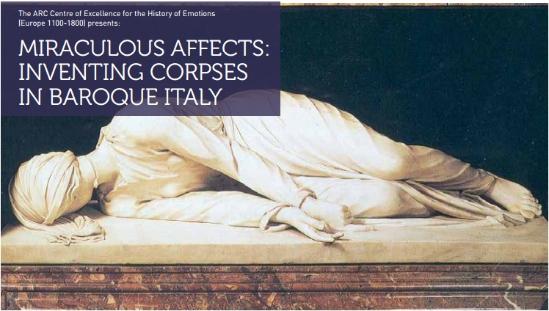
International Conference 'Fra i Doppi Muri', Rome
7-8 March 2014
The International Conference entitled 'Fra i Doppi Muri' will explore the claustral female art and culture in Rome during the early Modern period.
Check information here: Convegno Fra I Doppi Muri (MS Word ![]() , 162kb)
, 162kb)
New Approaches to Modern Naples
29 April 2014
The Cambridge Italian Research Network is hosting a workshop on New Approaches to Modern Naples on Tuesday, 29 April, at 5 p.m. at Gonville and Caius College Cambridge. Ruth Glynn (Bristol) will speaking on 'Occupied Naples between testimony and translation' and Nick Dines (Middlesex) on 'Interrogating narratives of renaissance and decline in contemporary Naples'. For more information, see: http://www.mml.cam.ac.uk/italian/research/Naples.jpg
We look forward to seeing Neapolitan Network members at the workshop.
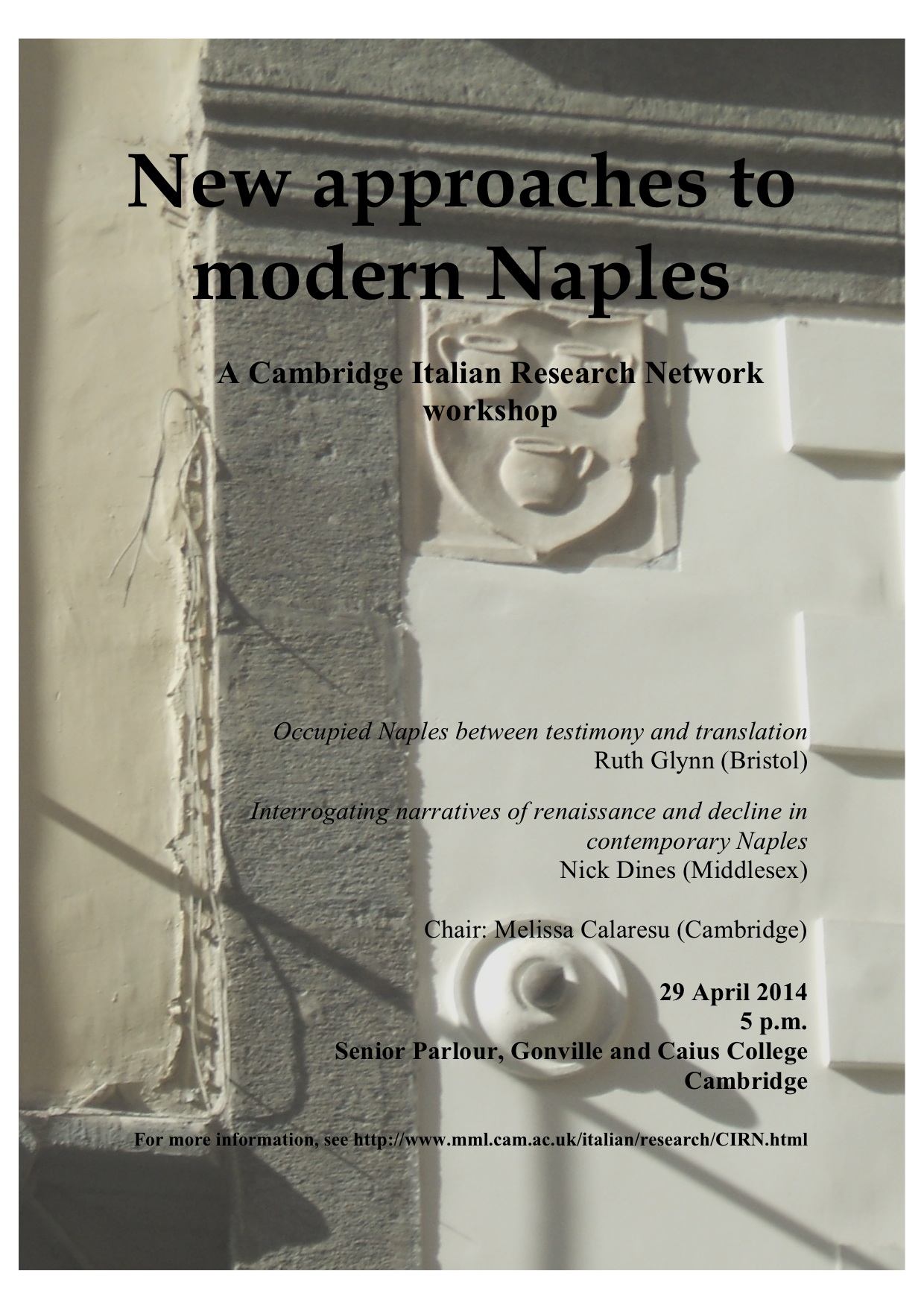
Neapolitan Network meeting in Barcelona
24 October 2014
The Neapolitan Network goes to Barcelona!
Visit the section related to the event to find out more!
CFP: Naples and Spain: Cultural and Intellectual Networks (1500-1800)
The next Neapolitan Network conference will take place on 24 October 2014 in Barcelona. The conference will be hosted by the Department of Early Modern History, University of Barcelona, and the research group, Power & Representations: Cultural Transfers in the Modern Age, which has recently published the on-line exhibition: Exchanging Views. The Viceroys of Naples and the Image of the Monarchy of Spain in the Baroque Age (www.ub.edu/enbach).This one-day conference will focus on relations between Naples and Spain, to include cultural and intellectual networks both within and outside of governmental sphere, for example, in relation to the history of collections, the history of science, and, more broadly, the history of material culture. Comparison with other Spanish imperial contexts would also be welcome.
For further info, please see the attachment: CFP: Naples and Spain (PDF ![]() , 419kb) or visit the page related to the event.
, 419kb) or visit the page related to the event.
2013
13 March 2013
Presentation of the forthcoming publication "Cerimoniale del viceregno spagnolo e austriaco di Napoli, 1650-1717" (PDF , 210kb), edited by A. Antonelli.
5 June 2013
The Italian Angevins: Naples and Beyond, University College London.
Download the Provisional Program for The Italian Angevins (PDF , 69kb).
View more details here.
13 September 2013
University of Cambridge.
Religion and Violence in Early Modern Naples: An interdisciplinary colloquium especially for emerging scholars. Download the 'Religion and Violence Poster (PDF , 321kb)
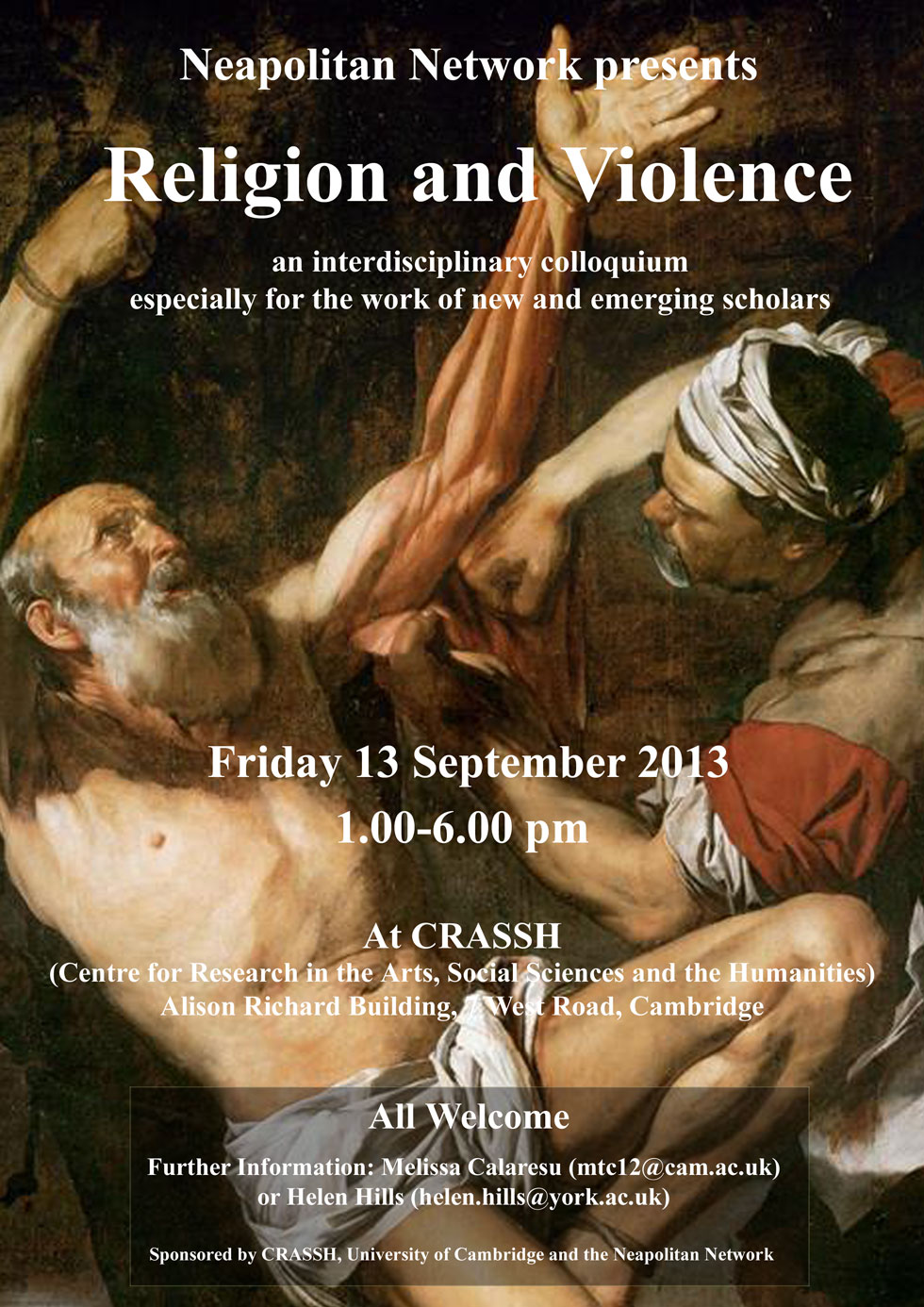
16 September 2013
"Cerimoniale del viceregno spagnolo e austriaco di Napoli, 1650-1717" (PDF , 210kb)
Symposium at the University of Cambridge
Further details: Dr M.Calaresu or Prof H Hills.
8 November 2013
Il Mare Non Bagna Napoli - The Bay Is Not Naples
Il mare non Bagna Napoli (PDF , 2,757kb)
London, Shaw Theatre
Saturday 23–Sunday 24 November
Gesualdo 400th Anniversary Conference, University of York
Celebrating the music of Gesualdo, the 400th Anniversary Conference will combine academic paper sessions with a series of singing workshops and performances throughout the weekend. James Wood will give a keynote speech on his reconstructions of Gesualdo’s second book of Sacrae Cantiones and forensic psychiatrist Dr Ruth McAllister will present an analysis of the murder of Gesualdo’s first wife based on contemporaneous accounts. On the Saturday, I Fagiolini will give a concert of secular music by Gesualdo and his contemporaries. On the Sunday, The 24 (a university of York Chamber Choir directed by Robert Hollingworth) will give a concert of sacred music, including some of James Wood's reconstructions and a set from the Tenebrae Responsories.
The academic conference will focus on the music of Gesualdo, his peers and their times.
Topics for consideration:
- The Music of Gesualdo
- Gesualdo’s peers and the artistic environment in Naples and Ferrara
- Contemporary parallels in other art forms to Gesualdo’s advanced and mannerist music
Proposals are welcomed from, but not restricted to, the topics listed above.
We would like to invite proposals for 20 minute individual research or recital papers (followed by 10 minutes discussion). Proposals should not exceed 250 words and should be e-mailed to: gesualdo400@gesualdo.co.uk
Please submit proposals as an MS Word or PDF document but please also include a plain-text version in the main email.
The following details need to be included in your proposal: name, institution, postal address, email address, telephone number, and audio/visual requirements.
A publication project based on the conference proceedings will be undertaken.
The deadline for receipt of proposals is 6th September 2013.
http://www.gesualdo.co.uk/400/callforpapers.pdf
2012
11 June 2012
La circolazione dei saperi scientifici tra Napoli e l’Europa nel XVIII secolo. (PDF ![]() , 505kb)
, 505kb)
2011
John Marino in Cambridge
John Marino (University of California, San Diego) will be presenting a paper entitled, 'Love, Fame and Revolt in Baroque Naples' on Thursday, 3 March, at 1 p.m. in the Leslie Stephen Room, Trinity Hall (Cambridge).
Professor Marino is the author of a recent book, Becoming Neapolitan: Citizen culture in Baroque Naples (Johns Hopkins, 2010; see www.press.jhu.edu)
30 April
Project Lingue in Festa – NAPULANG
Call for Papers
We invite contributions for a forthcoming interdisciplinary volume on the reception and cultural memory of Naples' classical past from antiquity to the present.
The volume will examine how the literary, archaeological and cultural traces of antiquity have been preserved in (and have shaped) the city, both within the Greco-Roman period and in later eras.
Potential areas for exploration might include: the use of the city’s Greek heritage to construct a distinctive Roman identity, the medieval use of classical spolia, early Renaissance city-guides and their treatment of classical monuments, the representation of ruins in the presepe Napoletano, De Jorio’s treatise on Gesture in Naples and Gesture in Classical Antiquity, the formation of the great Neapolitan collections of ancient art, and the memory of the classical past in contemporary Neapolitan culture.
The editors would welcome informal enquiries from potential contributors.
The initial deadline for titles and abstracts is 15th November 2010; the deadline for completed papers will be Autumn 2011.
An e-seminar on this topic is also planned for Spring 2011.
Jessica Hughes (jessica.hughes@open.ac.uk)
Claudio Buongiovanni (claudio.buongiovanni@unina.it)
26 May
Citizen cultures and ritual in early modern Italy and Spain
Senior Parlour, Gonville and Caius College, Cambridge
Programme 26 May 2011 (PDF ![]() , 250kb)
, 250kb)
13 June
- The Baroque as Empirical Sensibility: an International Workshop in the Social Life of Method
- Neapel Forum for junior scholars (PhD and post doc students)
20-22 October
Naples (Galleria di Palazzo Zevallos Stigliano, Palazzo Reale)
International Conference: Stately dwellings in Naples. Palazzo Zevallos Stigliano and aristocratic patronage from the 16th to the 20th century.
Programme (in Italian)
-
- Esterno programma Dimore Signorili formato A4 (PDF
 , 381kb)
, 381kb) - Interno programma Dimore Signorili formato A4 (PDF
 , 28kb)
, 28kb)
2010
The Arts and Sciences in Seventeenth- and Eighteenth-Century Naples: Discovering the Past, Inventing the Future
26-27 February 2010
The UCLA Center for Seventeenth- & Eighteenth-Century Studies at The William Andrews Clark Memorial Library
Programme (PDF ![]() , 89kb)
, 89kb)
In 2010 UCLA (University of California Los Angeles) hosted a conference dealing with Arts and Sciences in Naples, from Medieval to Contemporary times. Edited by John Marino and Carlo Vecce, and structured in three sections, the convention explored the issue of Neapolitan identity, the impact of scientific Academies, the Baroque and the Enlightment, finally concluding with blurring fiction and non-fiction on stage and in the print. All the papers presented are gathered in "The Disciplines of the Arts and Sciences in Naples: Medieval, Early Modern, Contemporary" (2012) Issue 1, Vol. 3 of the California Italian Studies Journal. Detailed programme: UCLA Clark Library (MS Word ![]() , 34kb)
, 34kb)
Sestieri Quartieri Seggi
18-20 Jun 2010
Flyer (PDF ![]() , 135kb)
, 135kb)
'Naples crucible of the world' Conference, Italian Cultural Institute of London / British Library,
29-30 October 2010
Organised by Dr. Mariano d’Amora
Programme (PDF ![]() , 123kb)
, 123kb)
Villa Medici Research Seminar
Visions and plans of Rome in the Renaissance: Compared perspectives.
29 October 2010, Rome
Italy and its Pasts' Conference, University of London, November 2010
19-20 November 2010
Poster (PDF ![]() , 120kb)
, 120kb)
Visit http://www.asmi.org.uk/conferences/ for full programme.
2009
XX convegno internazionale dell'Associazione Nazionale Musei Scientifici
18-20 November 2009
Invitation (PDF ![]() , 306kb) / Programme (PDF
, 306kb) / Programme (PDF ![]() , 507kb)
, 507kb)
Exoticizing Vesuvius Workshops 2009-10
Formations of Naples c.1500-present
Three Workshops at the Universities of York and Cambridge in 2009 Funded by the AHRC.
exorcizing Vesuvius poster (PDF ![]() , 364kb)
, 364kb)
Do you also want to have look at our workshops taken in 2009?
You are more than welcomed!
Workshops in 2009 booklet (MS Word ![]() , 66kb)
, 66kb)
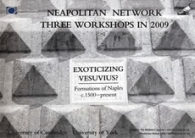
Don't forget to keep up with what is currently going on in Naples here.
Recent publications
Members are welcome to suggest relevant titles for this page. Particular emphasis will be given to publications authored by members. E-mail: fb798@york.ac.uk
Journal
Claudio Malice, member of the Neapolitan Network, proposes an interesting new reading of the marble decoration of the so-called 'Succorpo di San Gennaro'. The essay 'Abitare il Miracolo. Il Santo, il Cardinale e l'Antico: spunti per una (ri)lettura del Succorpo di San Gennaro' is published in the second issue of the new magazine 'ZEUSI. Linguaggi contemporanei di sempre' (anno 1, n.2, pp. 17-28). Please see the essay and the magazine following this link.
Book
New Approaches to Naples, a collection of essays, edited by Melissa Calaresu and Helen Hills, drawn together from our AHRC-funded Neapolitan Network Workshops. Please click on the image below for a link to the book. Read a review here.
There is a special reduction on the book through Ashgate. The promotional code is H9CEW20. Check also our Publications and Special Reductions page.
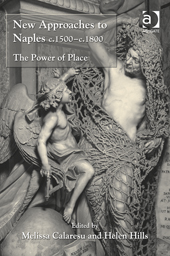
Book
Edited and introduced by Bruce Haddock and Filippo Sabetti, and translated by David Gibbons, the volume devoted to Vincenzo Cuoco, intends to go deeper in the work of the writer of “Historical Essay on the Neapolitan Revolution of 1799”, which has magnificently synthetized the thinking of brilliant figures, such as Machiavelli and Vico, and later on influenced other contemporary intellectuals, as Croce and Gramsci. Vincenzo Cuoco (PDF ![]() , 1,911kb)
, 1,911kb).jpg)
Journal
The Neapolitan Network is delighted to announce De Vito Foundation's annual issue, "Ricerche sull'arte a Napoli in Età Moderna. Saggi e documenti 2012-2013", which aims to renew and broaden those interest already traceable in "Ricerche sul '600 napoletano", published in 1982. Click here to download the cover and browse the contents.Fondazione De Vito (PDF ![]() , 497kb)
, 497kb) .jpg)
Book
New Neapolitan Network Member, Dr Serena Bisogno, explores the eclectic figure of Nicolò Tagliacozzi Canale (1691-1763), in a volume entitled Nicolò Tagliacozzi Canale. Architettura, decorazione, scenografia dell'ultimo rococò napoletano. The book does justice to this brilliant figure, whose work remains unknown to some extent, by returning a fascinating biographical and artistic portrait. The volume is now available in paperback as well, at this link: http://www.fridericiana.it/schedanew.asp?isbn=9788883381287, or via IBS: http://www.ibs.it/code/9788883381287/bisogno-serena/nicol-o-tagliacozzi-canale-architettura.html. Bisogno also wrote a paper on the marble trade of the 18th century, revolving around the figure of the Count Abbot Antonio del Medico. Her work appeared on the review "Napoli Nobilissima", available here: Commercio Marmi- Serena Bisogno (PDF ![]() , 615kb)
, 615kb)
Book
Linda Safran, Researcher Fellow at the Pontifical Institute of Medieval Studies , in Toronto, and editor of the journal Gesta, examined Salento (in Southern Italy) and its artistic heritage. The region relies on an outstanding tradition of wall paintings and inscriptions, graffiti and carved tombstone decorations, all of them going back to Latin as well as Greek roots. Click on the Pdf to know how to get the book! Linda Safran-Salento (PDF ![]() , 87kb)
, 87kb)
.jpg)
Book
Prof and Neapolitan Network member Michele Rak, A dismisura d'uomo, :duepunti Edizioni (2013). The author offers an insight into the extraordinary tradition of Baroque feasts in Naples and Rome. A dismisura d'uomo- review (PDF ![]() , 85kb)
, 85kb)
Book
Michele Rak investigated Arts, Theatre and Poetry of Neapolitan Baroque in L'occhio barocco (2012). Read a review here.-170x252.jpg)
Book
Dr Kathleen M. Bennett completed a research on The Sicilian Rococo. It is entitled The Rococo in Sicily: Assimilation of a Style (2012).
Book
Neapoltan Network Member Nick Dines worked on a book entitled "Tuff City: Urban Change and Contested Space in Central Naples", published by Berghahn Books in Jannuary 2012. Click here for more info.
Book
Victor Mínguez Cornelles, Inmaculada Rodríguez Moya, Pablo González Tornel and Juan Chiva Beltrán, member of Iconografía e Historia del Arte (IHA) research group at the Universitat Jaume I in Castellón (UJI), Spain, wrote "La fiesta barroca. Los virreinatos americanos (1560–1808)" (Castellón, 2012) [The Baroque Festival. The American Viceroyalties (1560–1808). Authors recenty awarded the 16th Spanish National Prize for the best academic edition by the University of Las Palmas de Gran Canaria.
- Victor Mínguez Cornelles, Inmaculada Rodríguez Moya, Pablo González Tornel and Juan Chiva Beltrán"La fiesta barroca. El Reino de Valencia (1599-1802)" (Castellón, 2010) [The Baroque Festival. The Kingdom of Valencia (1599–1802)].
- Ernesto Pontieri, Robert Almagià, Rosario La Duca, Ernestomazzetti,Cartografia Generale del Mezzogiorno e della Sicilia - Naples, Edizioni Scientifiche Italiane, 1972 (Noteout of print, only 1 copy available through Libreria Neapolis, priced at 300 euros).
- Elio Catello, Corrado Catello, La Cappella del Tesoro di San Gennaro- Naples, Edizione del Banco di Napoli, 1977(Note: out of print, just 2 copies available through Libreria Neapolis, priced at 110 euros each.
- Paolo Toschi, Renato Penna, Le tavolette votive della Madonna dell'Arco- Cava de' Tirreni, Emilio Di Mauro, 1971(Note: out of print, just 1 copy available through Libreria Neapolis, priced at 100 euros)
- Maria Bonghi Jovino, La necropoli preromana di Vico Equense-Cava de' Tirreni, Emilio Di Mauro, 1982(Note: out of print, just 1 copy available through Libreria Neapolis, priced at 60 euros).
- Angela Caròla Perrotti, Le porcellane napoletane dell'Ottocento (1806 - 1860) Naples, Grimaldi & C., 1990(Note: out of print, just 1 copy available through Libreria Neapolis, priced at 80 euros).
- Achille dell Ragione, 2011. Giacomo Farelli: Opera Completa, Napoli, Napoli Arte.
- Paolo Jorio, 2011. Le meraviglie del Tesoro di San Gennaro. Roma, De Luca.
- Johann Jacob Volkmann, 2010. Napoli e i suoi dintorni. Napoli, La Scuola di Pitagora.
- Pierluigi Leone De Castris, 2011. Studi su Gian Cristoforo Romano . Pozzuoli,Paparo.
- Anna Delle Foglie,2011. La cappella Caracciolo del Sole a San Giovanni a Carbonara. Milan , Jaca Book.
- Paolo Jorio, Franco Recanatesi, 2010. Le dieci meraviglie del tesoro di San Gennaro. Roma, istituto Poligrafico dello Stato.
- Achille della Ragione, 2011. Nuovi saggi sui pittori napoletani del Seicento. Naploli, Napoli Arte.
- Palos Joan Lluis, 2010. La mirada italiana: Un relato visual del imperio español en la corte de sus virreyes en Nápoles (1600-1700). Valencia, Publicacions de la Universitat de València.
- Leonardo Sacco, 2009. Il Corpo e il Sangue. Forme religiose di automortificazione e traiettorie simboliche nelle tradizioni popolari del Mezzogiorno d’Italia e delle Isole Filippine. Rome, Aracne.
- Mario Alberto Pavone (ed.), 2010. La fortuna del Barocco napoletano nel Veneto. Dipinti napoletani del Sei e Settecento dal Veneto(exhibition catalogue, plus essays by Stefania Mason and Linda Borean). Foggia, Grenzi.
- Barbara Ann Naddeo, 2011. Vico and Naples: The Urban Origins of Modern Social Theory. Ithaca (NY), Cornell University Press.
- Vito Teti, 2011 (1993). La Razza maledetta: Origini del pregiudizio antimeridionale Roma, ManifestoLibri.
- Francesco Senatore, Francesco Storti (eds.), 2011. Poteri, relazioni, guerra nel regno di Ferrante D’Aragona, Napoli, ClioPress.
- Edoardo Scarfoglio, 1897. Il cristiano errante, Roma, Enrico Voghera (ONLY ONE AVAILABLE through Libreria Neapolis, priced at 38 euros).
- Pasquale D'Angelo, 2011. La tradizione del canto a Napoli (book + CD), Napoli, Editoriale Scientifica.
- Annamaria Panzera, 2011. Caravaggio, Giordano Bruno e l'invisibile natura delle cose, Roma, L'asino d'oro.
- Alfonso Mattia Berritto, 2011. Pompei 1911: Le Corbusier e l'origine della casa. Napoli, Clean, 2011.
- Fabrizio Ludovico Porcaroli, 2011. Il `San Bastiano Medici` di Andrea del Sarto, Roma, Gangemi.

